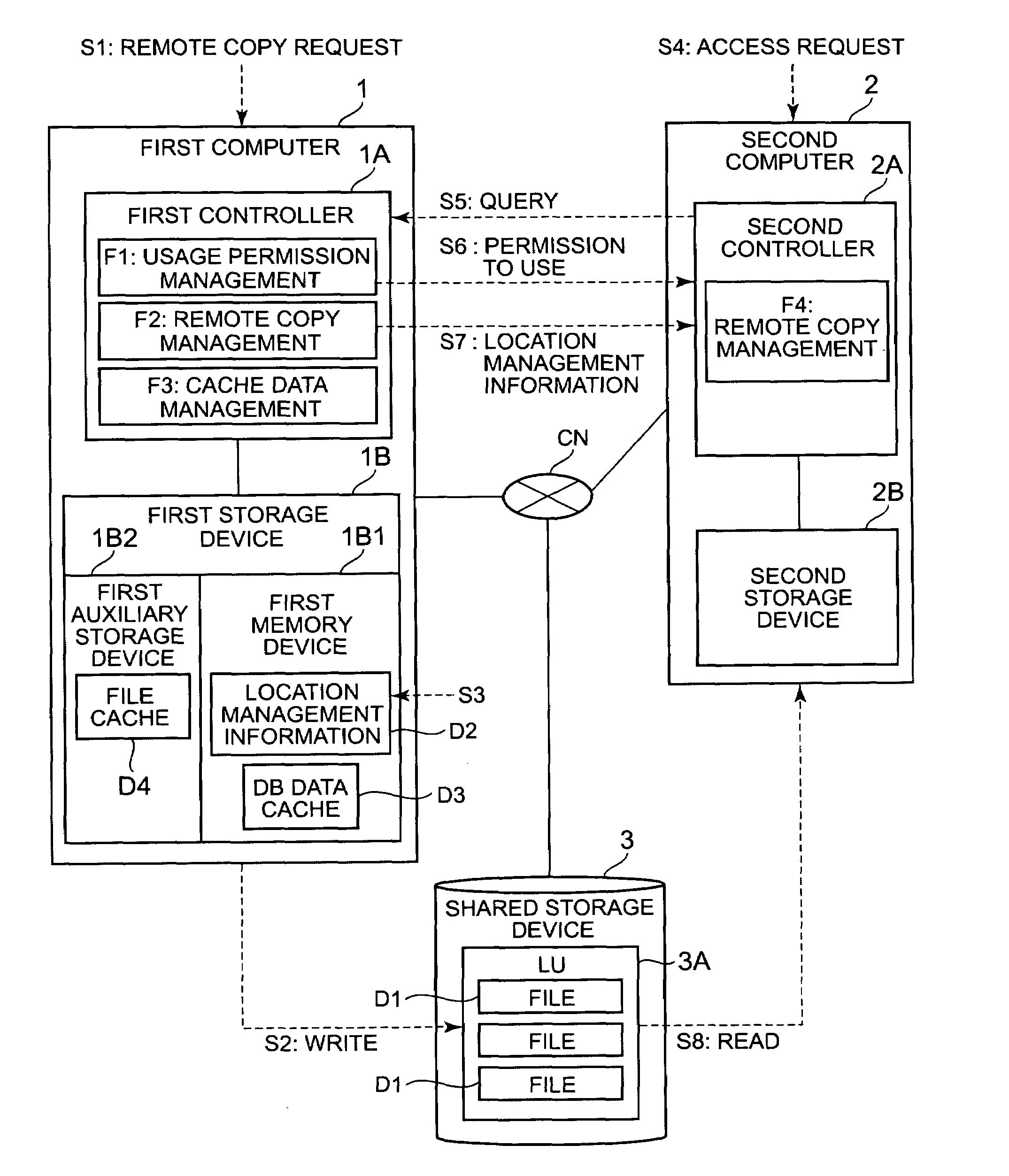Computer system, remote copy method and first computer
- Summary
- Abstract
- Description
- Claims
- Application Information
AI Technical Summary
Benefits of technology
Problems solved by technology
Method used
Image
Examples
first embodiment
[0090]FIG. 2 is a schematic diagram showing the overall configuration of a computer system related to this embodiment. The corresponding relationship with FIG. 1 will be explained first. A first server 10 corresponds to the first computer 1 of FIG. 1, a second server 20 corresponds to the second computer 2 of FIG. 1, a network storage device 30 corresponds to the shared storage device 3 of FIG. 1, communication networks CN10 and CN11 correspond to the communication network CN of FIG. 1, and a logical volume 33 corresponds to the logical volume 3A of FIG. 1. A connection controller 16 in FIG. 3 corresponds to the usage permission function F1 of FIG. 1, a remote copy manager 12 in FIG. 3 corresponds to remote copy management F2 of FIG. 1, and a cache data manager 13 in FIG. 3 corresponds to cache data management F3 of FIG. 1. A remote copy manager 22 in FIG. 3 corresponds to remote copy management F4 of FIG. 1, a DAS 15 in FIG. 3 corresponds to the first auxiliary storage device 1B2 o...
second embodiment
[0180]A second embodiment will be explained on the basis of FIGS. 16 and 17. The embodiments that follow, to include this embodiment, correspond to variations of the first embodiment. Therefore, explanations that duplicate those given for the first embodiment will be omitted, and the explanation will focus on the characteristic features of this embodiment. In this embodiment, as will be described hereinbelow, cache data management is excluded.
[0181]FIG. 16 is a flowchart of a read process executed by the second server 20. The process comprises all the steps of the respective steps of S60 through S76 shown in FIG. 8, with the exception of steps S61, S62, S69 and S70 related to the management of cache data.
[0182]FIG. 17 is a flowchart of a write process executed by the second server 20. The process comprises all of the respective steps from S90 through S105 shown in FIG. 10, with the exception of steps S91 through S93 related to the management of cache data.
[0183]Thus, the second serv...
third embodiment
[0184]A third embodiment will be explained on the basis of FIG. 18. This embodiment shows a variation of the processing of FIG. 9. FIG. 18 is a flowchart of a remote copy process in accordance with this embodiment. The process comprises all of the respective steps from S80 through S83 shown in FIG. 8. In addition, the process adds a new step S84 between steps S80 and S81.
[0185]In the new step S84, it is determined whether or not the command received from the host 40 prohibits the implementation of the remote copy process (S84). When the command prohibits the remote copy process (S84: YES), the second server 20 ends the processing. The second server 20 does not read out the remote copy target file even when the remote copy target file 34 exists inside the mounted logical volume 33.
[0186]By contrast, when the command received from the host 40 does not prohibit a remote copy process (S84: NO), the second server 20 reads out the remote copy target file 34 from the logical volume 33 (S81...
PUM
 Login to View More
Login to View More Abstract
Description
Claims
Application Information
 Login to View More
Login to View More - R&D
- Intellectual Property
- Life Sciences
- Materials
- Tech Scout
- Unparalleled Data Quality
- Higher Quality Content
- 60% Fewer Hallucinations
Browse by: Latest US Patents, China's latest patents, Technical Efficacy Thesaurus, Application Domain, Technology Topic, Popular Technical Reports.
© 2025 PatSnap. All rights reserved.Legal|Privacy policy|Modern Slavery Act Transparency Statement|Sitemap|About US| Contact US: help@patsnap.com



